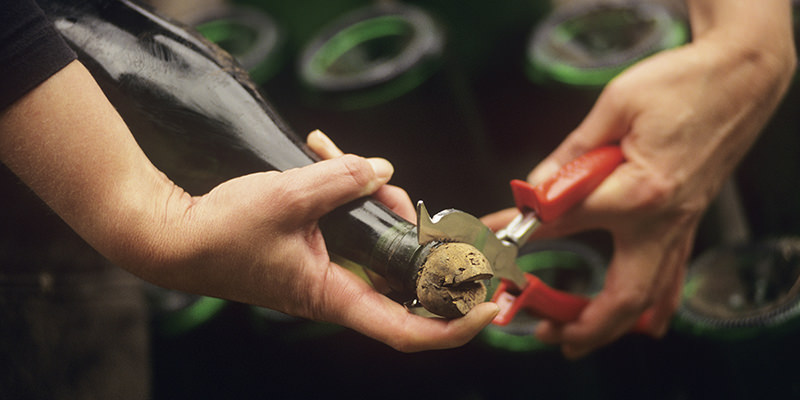I wasn’t sure what to expect when I walked under the metal grate and into Donkey and Goat Winery in Berkeley to help “disgorge” their Lily’s Cuvée Pet-Nat. All I knew was that the job required an apron.
The word disgorgement wasn’t unfamiliar–its the kind of term often bandied about in wine appreciation courses and books, and refers to the removal of yeast from finished bottles of sparkling wine.It’s these yeast that are responsible for putting the bubbles in bubbly, and without disgorgement, finished wines would be chewy and cloudy. Today, the process is usually completed by fancy machines that freeze bottle necks so the dead yeast, or lees, are expelled quickly and quietly from the bottles without losing much wine.
These descriptions of disgorgement may be accurate, but they hardly illustrate what the procedure truly entails.
Don't Miss A Drop
Get the latest in beer, wine, and cocktail culture sent straight to your inbox.Imagine shaking a beer bottle with the fervor of an angry toddler, then whipping the cap off and watching the foam explode in a frothy stream. Now imagine there’s also a pebble inside the bottle, which blasts out like a miniature asteroid.
Asteroid blasting is, in my opinion, a more accurate depiction of disgorgement than anything found in a book. Sticky brown lees even resemble the tails on shooting stars. The only real difference from the toddlers with beer example is that shaking isn’t necessary, thanks to the inherent high-pressure contained in bottles of sparkling wine.
Unlike Champagne, Méthode Ancestrale wines like Lily’s Cuvée go through a single fermentation which happens completely inside the bottle and are often referred to as Pet-Nat. “Pet-Nat,” or pétillant naturel is the common name for naturally-made sparkling wines. Unlike Champagne, which is dominated by reliable flavor profiles from vintage to vintage, Pet-Net is known for wild variation in flavor and sweetness not just between vintages, but between to bottle. These wines are made by bottling grape juice that’s still fermenting, then promptly capping it to finish and left alone to fermentation and age for several months in-bottle. .
At the end of this process, the bottles are rested upside down so that the SweetTart-flavored lees collect in the bottle’s neck, often around a small plastic bead called a bidule. The bidule helps hold the lees together so that less wine–and fewer bubbles–are lost during disgorgement.
Winemaker Tracey Brandt explained the process to me, standing in front of a blue plastic bin used to catch the lees and wine that burst from each bottle. “Rest the bottle on your belly, then stick it way out like a big beer belly,” she said. “Point the bottle forward horizontally, and pull the top off.”
With a loud bang the lees and bidule are expelled into the bucket, followed by a small amount of foamy, sweet Pet-Nat. the wine fizzes like the metaphorical beer bottle before being topped with still wine, in this case the same Anderson Valley Chardonnay used in the Lily’s Cuvée.
Once the fizz is under control, Lily’s Cuvée is topped off with still wine, in this case the same Anderson Valley Chardonnay that goes into the bubbly Lily’s.
Yes, it is as much fun as it sounds…for the first twenty bottles. After a few exciting cases, hands get sore and imitation beer bellies start to shrink, which can lead to dangerous flying bidules and lots of lost wine. Add in the very real danger of bottles spontaneously exploding, which is a constant worry for natural sparkling wine producers–fewer chemicals means less control over active fermentations.
Plus, everyone’s hands are wet and sticky and there’s glass everywhere! By case 50 the winery starts looking more like a battlefield than a red carpet fête.
So why push through the onslaught of lees and bidules, when still wines could simply be carbonated using the charmant method, which doesn’t require hand-numbing disgorgement or expensive machinery? Because though Pet-Nat may be dangerous, it also creates some of the most unique and surprisingly delicious wines on store shelves. Unlike the identical beverages at Starbucks or Prosecco bottles at a wine shop, Méthode Ancestrale sparklers offer surprise and adventure (and perhaps a rogue bidule) in every bottle.

